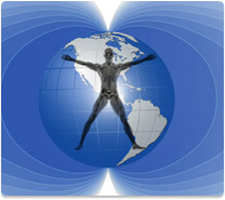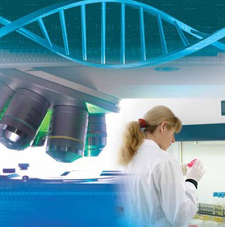|
By selecting the most appropriate target
structures, using new technology platforms such as ultra
high-throughput screening and genetics, we will be able to
discover and develop drugs that offer unprecedented efficacy and
safety.
 New Technologies :
New Technologies :
New technologies and areas of research are the basis for today's
revolution in medicine. Some of these have emerged over the past
few decades, others more recently. Molecular biology and its most
important instrument, genetic engineering, make it possible to
study biological processes in cells, organs and organisms at the
level of biomolecules. The causes of diseases can be identified.
Thus it was discovered, for example, how the human
immunodeficiency virus (HIV), the virus that causes AIDS,
penetrates and destroys white blood cells. In combination with
information technology, automation and new chemical techniques,
biosciences have the tools to develop new and better drugs.
 Genomics and Bioinformatics :
Genomics and Bioinformatics :
With the help of genomics and bioinformatics, researchers can
identify genes and mutations in genes which, though currently
unknown, play key roles in the development of diseases. Chip
technology is also useful in this search. It is now possible to
examine thousands of genetic sequences simultaneously on a DNA
chip with an area of a square centimetre and to analyse the
results in a matter of seconds. In this way diseased and healthy
tissue can be compared. For example, it is possible to identify
genes that are active in diseased tissue but not in healthy
tissue. Study of these genes may lead to the identification of an
important cause of the disease, and a target for a new form of
treatment, i. e. a molecule which can be influenced by a
therapeutic agent, can be found.
 Proteomics :
Proteomics :
Proteomics is gaining more and more importance. In investigating
the genetic causes of disease it is not enough simply to know the
genes involved and their DNA sequence. Symptoms of illnesses are
induced not by genes, but by proteins formed as a result of the
activity of certain genes. To enable us to understand and combat
illnesses we therefore need to investigate the proteins in the
body that are responsible for all biological processes – growth,
metabolism, illnesses etc.
Synthesising sufficient quantities of the proteins to be analysed
within an acceptable time frame is just not possible with
traditional methods. Taj Pharmaceuticals Molecular Biochemicals'
Rapid Translation System RTS 500 has overcome this problem; this
system can be used to produce a wide variety of proteins in
quantities of several hundred micrograms with ease.
 Discovery Chemistry :
Discovery Chemistry :
Once a target playing an important role in the disease mechanism
has been identified, the search for suitable medical substances
can begin. The biological target must be blocked or stimulated in
order to interfere with the disease process and if possible
initiate recovery. With the help of laboratory robots, many
different substances can be tested simultaneously. The aim is to
find molecules that react with the biological target and therefore
have potential as new drugs. Taj Pharmaceuticals has built a new
large compound depository in Basel and smaller 'substance
libraries' at the different research sites, storing a huge amount
of molecules which can be tested as potential new drugs.
 Ultra-High-Throughput Screening :
Ultra-High-Throughput Screening :
Only a few years ago this would have been a long-lasting
undertaking. The best laboratories managed in a project around
60,000 molecules per year. Now, thanks to automation, the same
number of substances can be tested in a day. This process of rapid
sifting through a library of substances is known as
ultra-high-throughput screening. Taj Pharmaceuticals and Zeiss,
Germany, developed together a new ultra-fast module which allows
to screen the compound library within one to two weeks.
 Computer-assisted Drug Design and Combinatorial Chemistry :
Computer-assisted Drug Design and Combinatorial Chemistry :
In many cases this screening process identifies a number of
potentially interesting substances. The chemical structure of
these substances is then optimised by computer-assisted drug
design and combinatorial chemistry. This technique permits the
production of a large number of variants of the substances within
a short time. Previously, a chemist could produce 50 to 100
variants of a substance per year. Now, thanks to new techniques,
scientists can produce around 50,000 in the same time.
|




